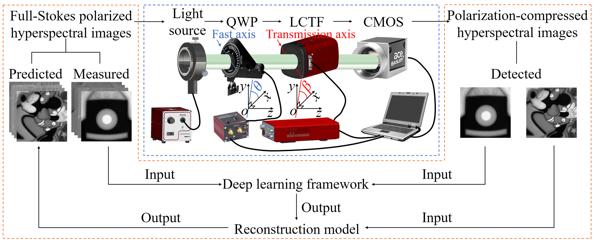Due to the rich information reflected, polarized hyperspectral imaging has been widely applied in environmental monitoring, biological diagnosis, food safety, and other fields. In terms of technology development, polarized imaging is mainly based on Fourier transform, pixelated polarizers, and compressive sensing (CS). Currently, all the above three methods can achieve full-Stokes polarized imaging. Typically, Fourier transform imaging spectropolarimetry based on polarization modulation array (PMAFTISP) requires only one acquisition to obtain full-Stokes images. The PMAFTISP includes three polarization modulation arrays and three independent optical elements. System complexity and channel crosstalk may affect imaging quality. In addition, pixelated full-Stokes polarimeters require rotating polarizers or designing metasurfaces. Moreover, the fabrication of precision pixelated devices is costly and time-consuming. Recently, compressive full-Stokes polarimeters are constructed with only two commercial components, providing an easy-to-operate and time-saving system. Full-Stokes images can be reconstructed from two measurements compressed by a quarter-wave plate (QWP) and a liquid crystal tunable filter (LCTF). Furthermore, benefiting from a retarder followed by a Wollaston prism with splitting effect, full-Stokes images can be reconstructed from one measurement. Nevertheless, the above compressive polarimeters all rely on traditional reconstruction methods, such as two-step iterative shrinkage/threshold (TwIST) algorithm, which require careful selection of polarization parameters and sparse basis.
The research team of Professor Xu Tingfa from Beijing University of Technology has developed full-Stokes single compression in polarized hyperspectral imaging by introducing deep learning reconstruction (DL-FSCPHI). Full-Stokes images of the target light are compressed into one measurement by a QWP combined with an LCTF. The full Stokes images are then reconstructed simultaneously by a convolutional neural network (CNN). The relevant results were published in Volume 21, Issue 5 of Chinese Optics Letters (Axin Fan, et al. Deep learning reconstruction enables full-Stokes single compression in polarized hyperspectral imaging) and was selected as the cover paper.
The shown figure 1 illustrates the overall schematic diagram of DL-FSCPHI method comprised of imaging system and polarization reconstruction. The imaging system mainly consists of a light source (Thorlabs, OSL2), a QWP (Thorlabs, SAQWP05M-700), an LCTF (Thorlabs, KURIOS-VB1/M), and a complementary metal oxide semiconductor (CMOS) detector (Basler, acA2040-180km). The polarization state of the target light is expressed by a column vector composed of four Stokes parameters. The polarization characteristics of both QWP and LCTF are described by a Mueller matrix with 16 elements in four rows and four columns. Furthermore, LCTF and QWP Mueller matrices are multiplied to obtain the system Mueller matrix. Then, the system Mueller matrix is multiplied by the Stokes column vector of the target light to obtain the Stokes column vector of the modulated light. The modulated first Stokes parameter representing the total light intensity is finally measured by the CMOS detector. Herein, the QWP and LCTF polarization angles are fixed and the LCTF center wavelength is switched to obtain the polarized hyperspectral images of the target under full-Stokes single compression.

Figure 1. Overall schematic diagram of DL-FSCPHI method
The polarization reconstruction involves model training and model testing. Initially, a CNN model composed of two convolution layers is built on Keras framework. The first convolution layer expands one compressed image into multiple images, and the second convolution layer enhances the image details to predict full-Stokes images. The model is then trained utilizing full-Stokes images and compressed images of 60 targets with 400×400 spatial pixels in 18 spectral bands. The model is tested utilizing full-Stokes images and compressed images of other 7 targets with 400×400 spatial pixels in 18 spectral bands. In order to fully verify the reliability of DL-FSCPHI method, two polarization angles, two model structures, and two training parameters are designed. Compared with typical TwIST algorithm, the average peak signal to noise ratio (PSNR) and structural similarity (SSIM) values are improved by 13.55 dB and 0.28, respectively.
This work demonstrates the great promise to develop deep learning reconstruction for full-Stokes single compression and other applications. In the future, it is worth investigating a stronger universal model that is widely applicable to different imaging systems and different polarization angles. Meanwhile, deep learning reconstruction is being extended to four-dimensional compressive imaging, including one-dimensional polarized, one-dimensional spectral, and two-dimensional spatial compression.


